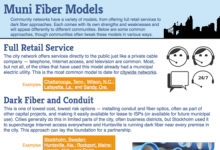"Muni Fiber Models" Fact Sheet
When local communities look for ways to improve connectivity, they may consider investing in a municipal fiber optic network. As they begin to review possible options, local officials, their staff, and community groups will realize that there are a number of potential models. We’ve put together the Muni Fiber Models fact sheet that takes a brief look at those models and provides some examples.
From “Retail” to “Tubes In The Ground”
Chattanooga is the most well known municipal Fiber-to-the-Home (FTTH) network and is offered by the community’s Electric Power Board (EPB). EPB’s service offers telephone, Internet access, and video service directly to subscribers. The fact sheet provides more examples of communities that have decided that full retail service is right for them. On the other end of the spectrum, places like Lincoln, Nebraska, provide only the infrastructure and lease it to private sector providers who then offer retail services to businesses and residents. The other approaches we find most commonly used include open access, I-Nets, and Partnerships between local government and the private sector.
We’ve included short explanations for each model and provide some examples for a starting point. We encourage you to share the fact sheet with others who are interested in learning about different paths to better connectivity through publicly owned networks.
Download the Muni Fiber Models fact sheet here.
Review our other fact sheets and check back periodically for new additions. Fact sheets are a great way to quickly and easily share information and cultivate interest in learning more.



